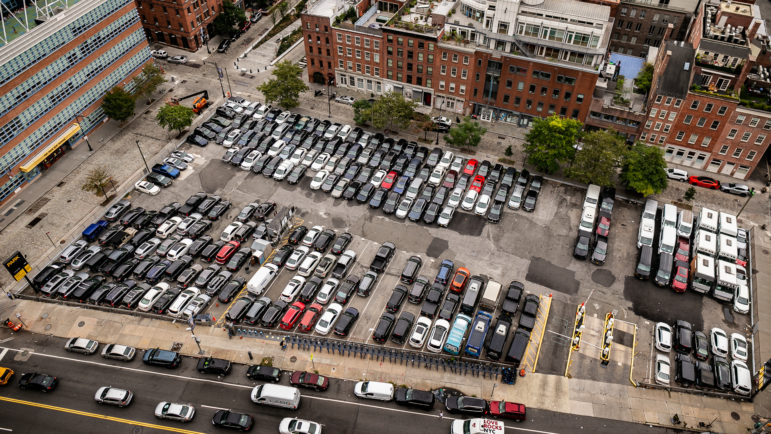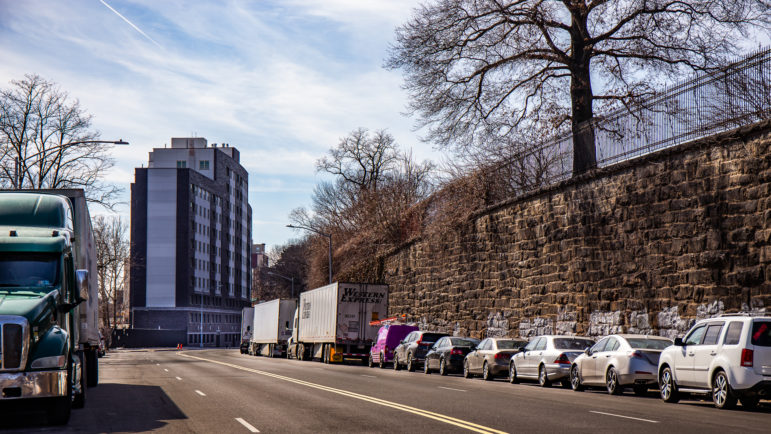What could a city like New York achieve if it repurposed some of its 3 million curbside parking spots? It could help drivers kick their addictions to cars and avert climate catastrophe, writes Henry Grabar, author of the new book “Paved Paradise: How Parking Explains the World.”

Adi Talwar
A parking lot in Lower Manhattan.This article originally appeared in Nexus Media News.
What could a city like New York achieve if it repurposed some of its 3 million curbside parking spots?
It could get rid of rats by moving trash off the sidewalks and into containers. It could create safe, cool play spaces for the more than 1 million New Yorkers without easy park access. It could build bioswales to collect rainwater and prevent flooding during heavy storms.
It could even help drivers kick their addictions to cars and avert climate catastrophe, writes Henry Grabar, author of the new book “Paved Paradise: How Parking Explains the World.“
Instead, the city devotes most of its curb space—an area equivalent to 52 Central Parks, according to advocacy group Transportation Alternatives—to parking.
“We have all this land that’s being currently allocated in one of the least efficient and least environmentally sound ways possible,” Grabar said. “If you begin to think about retrofitting and adapting that, the possibilities are endless.”
“Paved Paradise” reveals how cheap and convenient car storage exacerbates the housing shortage (the U.S. allocates more land to car storage than to housing), siphons public assets into private hands, blights downtowns and fuels the climate crisis.
Grabar, a staff writer at Slate, grew up in Lower Manhattan in the 1990s. In the book, he recounts travails familiar to anyone who has ever looked for parking in New York: His father used to drop the family off in front of their building before he set off in search of a curbside spot; as a teenager, Grabar was often tasked with sitting behind the wheel of his parked family’s station wagon, “…hoping I would not have to move the car when the ticket cop came. I was too young to drive.”
He has written about housing, transportation, and urban politics for the last decade. “In story after story, I kept finding this hidden factor that seemed to be determinative of the way various projects turned out,” he said. “That system was parking.”
Grabar traces much of the design and feel of modern U.S. cities to the postwar era, when American car ownership skyrocketed and much of the middle class moved to the suburbs. “The question of where to park all these cars consumed American politicians, shop owners, traffic engineers, and urban planners in the 1950s and 1960s,” he writes. “Cities sought to emulate the suburban parking model and very nearly destroyed themselves in the process.”
Today, Americans drive more than almost anyone else in the world, and transportation is the U.S.’s largest source of greenhouse gas emissions. (Electric vehicles may reduce emissions, but the need for chargers brings a host of other parking challenges, Grabar notes.) Americans’ propensity toward driving isn’t simply a function of our size—Americans drive 60 percent more than Australians and Canadians—but rather, he writes, “we built a country with exceptional rewards for driving and punishments for getting around any other way.”
Parking exacerbates the problem. When it’s free, there are often shortages, incentivizing drivers like his father to circle the same block several times in search of a spot. Across the country, zoning laws often require new developments to build a set number of off-street parking spots. Those rules, Grabar argues, create sprawl (which in turn incentivizes more driving) and fuel the current housing shortage.
READ MORE: Free Parking—Is it the Secret Ingredient in NYC’s Traffic Problem?
“I think people’s opposition to new neighbors is often motivated by their fear of traffic and parking problems,” Grabar said. If cities provide comfortable and convenient alternatives to cars, “you can defang one of the most prevalent NIMBY arguments, which is really about traffic and parking. Rarely do you hear people say, ‘There were too many people on the sidewalk’ or, ‘There are too many people at the park.’”
The U.S. has the highest rate of road accidents of any OECD country, and traffic fatalities are on the rise. In 2021, some 43,000 people, including more than 7,000 pedestrians, died on U.S. roads, making it an outlier among economically advanced nations.
The problem is particularly acute in low-income and minority communities, which are less likely to have sidewalks, marked crossings and other designs meant to make spaces safe for pedestrians. Black pedestrians are nearly twice as likely to be struck and killed in traffic as white pedestrians.
Low-income and minority communities are also disproportionately exposed to air pollution—often the result of traffic emissions—and suffer higher rates of asthma and other respiratory ailments.
Grabar points out another, perhaps overlooked way that parking contributes to the climate crisis: Cement is responsible for nearly 10 percent of global greenhouse gas emissions, much of which goes toward the provision of parking. And all that pavement contributes to the loss of wetlands, forests and other greenspaces, a process that can release carbon into the atmosphere and reduce biodiversity.
Paving over our cities also makes them less able to adapt to a changing climate. Asphalt and cement contribute to the urban heat island effect, which means that these surfaces create areas that can be several degrees warmer than green spaces nearby. Because of historic redlining practices, minority and low-income communities are more likely to live in urban heat islands.

These impervious surfaces also make cities more susceptible to flooding, another phenomenon on the rise as the planet warms. In Houston, Grabar writes, 50 years of unfettered growth “have sealed a Belgium-sized section of Texas grassland beneath asphalt, concrete, and land.” When Hurricane Harvey dumped more than 100 billion tons of water on the state in 2017, the water had nowhere to go.
But if “Paved Paradise” is an indictment of what parking has done to the modern American city, it’s also an invitation to imagine what else is possible. In 2011, when the Bill & Melinda Gates Foundation moved 1,200 employees to a new headquarters in Seattle, it began charging for on-site parking while offering free bike lockers and transit cards. The share of workers who drove to work fell from 90 percent to 34 percent in six years. In Paris, officials have removed thousands of curbside parking spaces, including in front of some 200 schools.
“It creates this beautiful intermediary space between the school and the streets where kids can play and their parents and people walking by can gather,” Grabar said.
As New Yorkers have seen in recent years with the construction of more than 12,000 outdoor dining sheds, repurposing the streets transformed the city’s restaurant scene and helped sustain thousands of businesses during a pandemic.
Of course, parking is a political lightning rod that Grabar grapples with throughout the book. Curbside parking is such a ubiquitous feature of urban life that many of us fail to see what it has taken away from our cities’ landscapes.
Returning to the New York proposal to convert curbside parking into trash containers, Grabar asked me to imagine a city with functional sanitation. “[Imagine] if the city said, ‘We found a way to create 150,000 extra parking spaces, but we’re going to throw the trash all over the sidewalk. You’re gonna have to walk through it, and there’s going to be a ton of rats,’” he said, describing the current state of affairs.
“I don’t think anyone would say that’s a better system.”









One thought on “How Our Obsession With Parking Fuels the Climate Crisis”
In the lower-density parts of the outer boroughs a car is a necessity, especially in eastern Queens and in Staten Island. 88% of the cars in NYC are in the outer-boros. The war on cars is a war on the NYC middle-class, and 80% of outer-borough home owners are also car owners.
NYC vehicle registrations –
Boro | Vehicles | % of NYC Total
BX | 294,069 | 13.12%
BK | 557,131 | 24.86%
MN | 256,630 | 11.45%
QN | 847,495 | 37.81%
SI | 286,096 | 12.76%
(Outer Boros only | 1,984,791 | 88.55%)
NYC TOT | 2,241,421 | 100.0%
NYC car ownership stats (pdf) – http://u.pc.cd/jf8